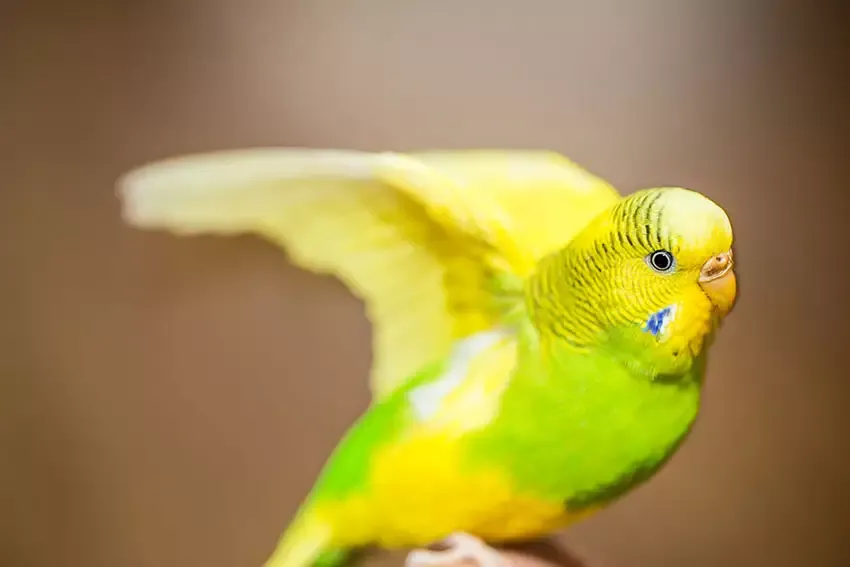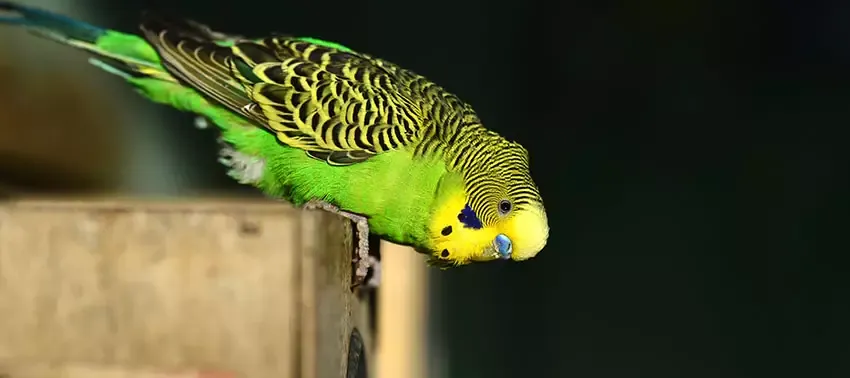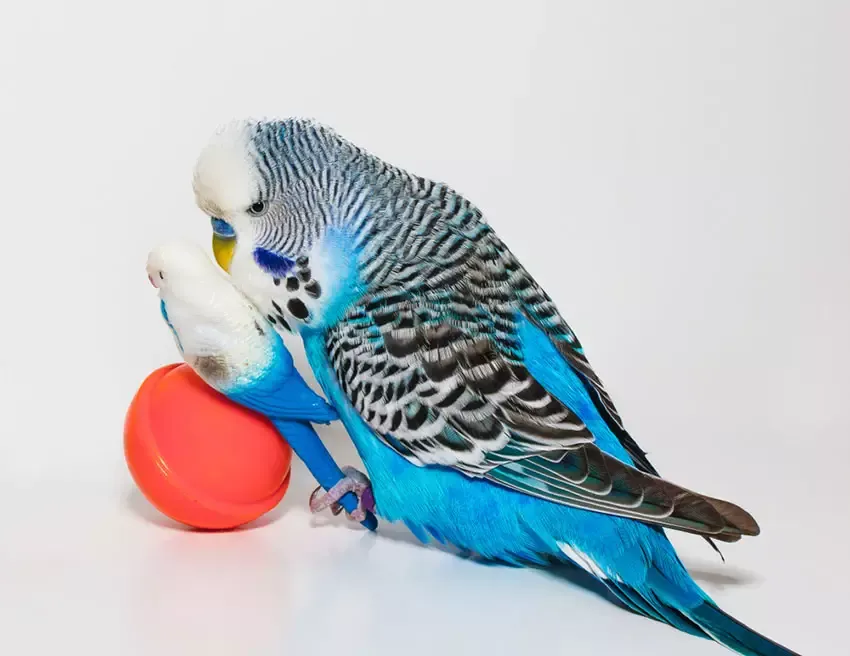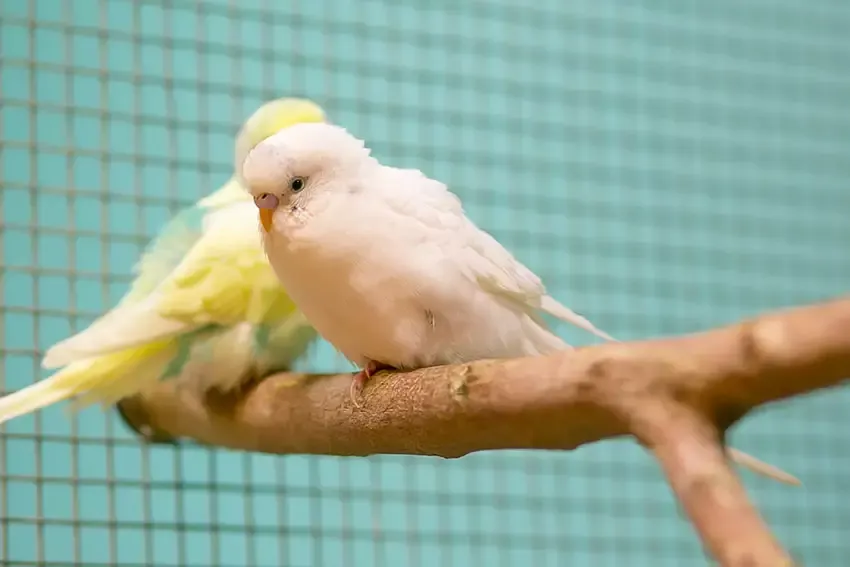Parakeets, also known as budgerigars, are fascinating creatures with a rich repertoire of behaviours that offer insights into their well-being and emotional state. Understanding typical Parakeet Behaviour is crucial for every owner, as it helps in identifying contentment, potential issues, and strengthens the bond between you and your feathered friend. From daily stretches to complex social interactions, these small birds express themselves in myriad ways, often reflecting instincts rooted in their wild counterparts.
Understanding Parakeet Body Language and Daily Habits
Observing your parakeet’s routine actions provides valuable clues about its health and happiness. These seemingly simple behaviours are fundamental to their daily life.
Wing Stretching: A Sign of Comfort and Exercise
Just like humans and other animals, parakeets need a good stretch, especially after periods of inactivity or sleep. You’ll often see your bird extend one leg and the corresponding wing outwards, showcasing its beautiful feathers before switching to the other side. This is typically followed by raising both wings high to complete the stretch, promoting blood flow to their muscles. This silent activity is a natural part of their morning routine or after a long nap and should not be mistaken for the more agitated wing-raising that can occur during disputes over food. It’s a clear indicator of a relaxed and healthy bird.
The Curious Case of Head Bobbing
Male parakeets are particularly known for their energetic head bobbing, a rapid, fluid up-and-down motion of the neck often accompanied by chattering. This behaviour is a significant part of their courtship display, especially when a male is trying to impress a female companion. If successful, this can lead to mutual feeding and eventually mating. Beyond courtship, head bobbing is generally a sign of excitement and happiness. Outgoing birds tend to bob their heads more frequently, directing this display towards other males, toys, mirrors, and even their human companions. If you acknowledge and encourage this behaviour, a tame bird may engage in it more often, indicating a positive emotional state.
 Parakeet stretching a wing and a leg
Parakeet stretching a wing and a leg
Young parakeets also exhibit head bobbing, though for a different reason: to signal hunger. Once weaned and perching with adults, chicks may continue this action, often paired with a “feed me!” chirrup, hoping their parents will still provide food. Eventually, parents will encourage independence, and the young birds learn to forage for themselves.
Physical Activity and Natural Instincts
Parakeets are active birds that require regular exercise and outlets for their natural instincts, such as chewing and climbing.
The Importance of Exercise and Flight
Early in the morning, parakeets frequently engage in vigorous wing flapping while perched. Sometimes their feet will briefly leave the perch as they hover noisily. This isn’t a display of aggression but rather a way for them to warm up their muscles and circulate blood after a night’s rest. This “mad flapping” is often accompanied by calls and chirrups. It’s important to remember that this confined flapping is not sufficient exercise. Parakeets need ample room for proper flight. If kept in a cage with limited flight space, it is crucial to allow them supervised time outside their cage to fly around the room and stretch their wings properly. They also enjoy gymnastics, frequently climbing the sides and roofs of their cages, demonstrating their agility and strength.
Chewing: A Natural and Necessary Instinct
Chewing is an innate and vital instinct for parakeets, serving multiple purposes from beak maintenance to exploration. Owners must provide appropriate items for them to chew on, as they will naturally seek to satisfy this urge. Balsa wood, untreated wooden perches, or sticks are ideal choices. These materials allow them to safely wear down their beaks, preventing overgrowth and keeping them healthy. It’s important to note that cuttlefish bone, while providing calcium, crumbles into powder and does not offer the same resistance for chewing. Providing a variety of safe chew toys is essential for your parakeet’s physical and mental health, redirecting their natural urge from potentially destructive behaviours.
 Parakeet with head down, possibly bobbing
Parakeet with head down, possibly bobbing
Play, Interaction, and Mental Stimulation
Mental stimulation and interaction are paramount for a parakeet’s well-being. Toys play a significant role in their daily lives, offering both amusement and exercise.
Engaging with Toys: Keeping Your Parakeet Entertained
Parakeets are naturally curious and will investigate anything new introduced into their cage. They’ll explore every corner of a new item with their beak, nibbling at its edges. Some birds are more timid and may take hours or even days to gather the courage to approach a new toy, depending on their individual personality. Once they’ve thoroughly explored and played with an item for a few days, their interest may wane. To maintain their engagement and prevent boredom, it’s crucial to rotate toys regularly, replacing old ones with new or different options. Toys that hang from the cage roof, move, or make sounds provide hours of exercise and amusement. Rolling items, like ping-pong balls, are also popular, as many birds enjoy nudging them across the cage floor with their beaks.
The Allure of the Bell: When a Toy Becomes an Obsession
Bells are frequently a favourite toy for parakeets, especially those living alone, due to their movement and sound-making capabilities. Tapping and ringing a bell can easily become a deeply ingrained part of a parakeet’s routine. However, this interaction can sometimes escalate into obsessive behaviour, indicating that the bird may need more social interaction, ideally with companions. While removing a cherished bell might initially upset your parakeet, these intelligent and adaptable birds will typically shift their attention to other activities or items in the cage over time. The most effective way to address bell obsession, and provide a richer life for your bird, is to introduce a companion into its cage, fostering natural social behaviours.
 Parakeet playing with a variety of toys
Parakeet playing with a variety of toys
Subtle Cues and Health Indicators
Beyond overt actions, parakeets display subtle cues that communicate their state of mind or physical condition. Learning to read these can help you understand your bird better.
Eye Pinning: Glimpses into Parakeet Fascination
Eye pinning, sometimes referred to as eye flashing, is a captivating behaviour where a parakeet’s pupils rhythmically dilate and contract. This often occurs when the bird is intensely focused on something interesting, such as a favourite toy or an exciting new object. It signifies engagement and curiosity. This phenomenon also occurs when a male bird is about to regurgitate food for its mate or a close companion, a gesture of affection and bonding. Another subtle sign of a parakeet’s curiosity is when they tilt their head to one side, attempting to get a better view or angle on whatever has caught their attention.
Yawning: More Than Just Tiredness
Just like humans, parakeets yawn when they are tired. Their beaks open wide, eyes may close briefly, and their neck stretches out. This can happen several times in succession and is generally a normal precursor to sleeping, so there’s usually no cause for concern. Interestingly, parakeet yawns can be quite contagious, and you might even find yourself mirroring your bird’s yawn! However, if your parakeet’s beak remains open for an unusually long time, or if the yawning is accompanied by head shaking or coughing sounds, it could indicate a health issue. This might signal a blockage or respiratory problem, and in such cases, it is important to seek veterinary attention promptly.
Social Dynamics and Bonding
Parakeets are inherently social creatures, and their interactions with other birds and even humans are central to their well-being.
Behaviour in Pairs: The Joys of Companionship
Parakeets are social birds that typically thrive in the company of their own kind. A pair often forms a self-contained miniature flock, engaging in the grooming, chattering, and socialising behaviours natural to their species in the wild. While rare, it is possible for two parakeets not to get along, in which case they might fight or simply avoid each other, staying on opposite sides of the cage without interaction. In such situations, mutual grooming will be absent, and they won’t sit and chatter together. If this occurs, separating the birds might be necessary. Sometimes, introducing a mirror can help break the ice, as the birds might interact with their reflection, potentially shifting the social dynamic enough for them to become friendlier towards each other. When a pair gets along well, the male will often sing his best songs and bob his head, perhaps even offering regurgitated seed as a loving gesture. They will touch beaks and frequently preen each other’s faces and heads, demonstrating their close bond by staying near each other, often side-by-side on a perch.
Forming Bonds: With Flock Mates and Humans
From the moment a parakeet leaves its nest for a perch, it integrates into the flock, and its behaviour becomes centered on bonding. They quickly merge their lives with others, eating, grooming, chattering, flying, and washing together. Parakeets forge bonds by participating in shared activities. When two birds become close friends, they will tap their beaks together in a “parakeet kiss” and often preen each other’s faces and heads. If you choose to keep a single parakeet, you must take on the role of its flock, providing essential social stimulation. This involves talking to your bird, allowing it out of the cage for supervised interaction, and letting it sit with or on you as you go about your day. With consistent time and dedication, you can form a deep and satisfying bond with a tame parakeet, enriching both your lives.
 Two white spangle parakeets perched closely
Two white spangle parakeets perched closely
Preening and Mutual Grooming: Essential for Health and Social Cohesion
Preening is a parakeet’s equivalent of a shower, crucial for maintaining clean, well-groomed feathers. Like many birds, parakeets possess a feather-oil gland at the base of their tail. During preening, they transfer this oil to their beak and meticulously run it down each feather, starting from where the feather attaches to the skin. Every feather requires this thorough treatment, making preening a time-consuming activity. This is often a communal activity within a flock, further strengthening social bonds. A preening session typically concludes with the bird puffing up its feathers and giving a violent shudder to settle everything into place, followed by a swift wag of the tail as a finishing touch.
Mutual preening is a common and affectionate behaviour, particularly addressing areas a bird cannot reach itself, such as the face and head. While a parakeet can scratch these areas with its foot, nothing compares to the comfort and thoroughness of a partner’s grooming. Pairs, regardless of gender combination, will oblige each other by preening these hard-to-reach spots. If your bird lives alone and is hand-tamed, you can offer a substitute by gently scratching its head with your finger. If your parakeet fluffs up its head and closes its eyes, you’re likely doing it right, providing a comforting experience akin to mutual grooming. However, if it keeps its feathers tight or nibbles at your finger, it suggests you haven’t quite found the “magic touch” they seek.
Conclusion
Understanding the intricate world of parakeet behaviour is a rewarding journey that deepens the connection between parakeets and their human companions. From their playful head bobbing and meticulous preening to their vital chewing instincts and social bonding rituals, each action tells a story about their health, happiness, and natural inclinations. By observing and responding to these cues, owners can provide an enriching environment that caters to their parakeets’ needs, ensuring they thrive both physically and emotionally. Remember that a well-understood parakeet is a happy parakeet. Continue to observe your feathered friends closely, and you’ll unlock an even greater appreciation for these remarkable birds. Explore more articles on “Dog Care Story” for further insights into pet care and well-being!
